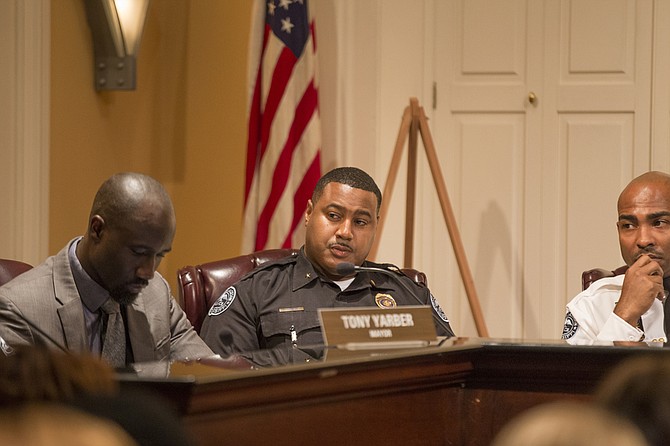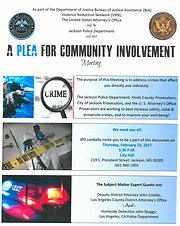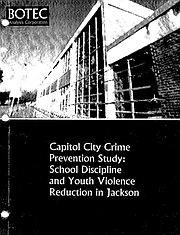From left: Mayor Tony Yarber, JPD District Commander Duane Odom and Commander Tyree Jones were three of nine men on the City Hall dais during a violence-reduction forum on Feb. 23. The discussion didn’t go off exactly as announced, however. Photo by Imani Khayyam.
JACKSON — It felt more like a bait-and-switch. But maybe the City Hall gathering was a start of a new way of thinking about crime prevention in the capital city.
The Jackson Police Department had announced the "Plea for Community Involvement" meeting for Feb. 23 at City Hall with a release promising what sounded like a forward-thinking discussion about reducing violence. The host list was limited to law enforcement and not the larger crime-prevention community, however: The U.S. Department of Justice, the federal Violence Reduction Network, the U.S. Attorney's Office and JPD would facilitate the conversation.
The flyer also promised presumably helpful "subject matter guests" from a metropolis that has improved its multi-faceted approach to reducing crime: Los Angeles Deputy Attorney General John Colello and LAPD homicide Det. John Skaggs, who is featured in Jill Leovy's best-selling book, "Ghettoside: A True Story of Murder in America," for his refusal to ignore violence against people of color in challenged communities.
Neither Colello or Skaggs were in City Hall, though, on Feb. 23, with Skaggs surprised when reached the next day that he was scheduled to be part of a public discussion. Six of the men on the dais wore JPD uniforms. The men in suits were from the Drug Enforcement Administration and Alcohol, Tobacco and Firearms, soon joined by the mayor. Jones, JPD's spokesman, said later that representatives from the U.S. Attorney's Office sat in the audience.
The hour-long meeting wasn't exactly revolutionary—crime is bad; people need to be smarter; anger must be managed; police can't prevent murder; and yes, we'll flash more blue lights around town—but glimmers of bigger thinking on crime broke through here and there.
Heartbreaking Homicide
Larry Nelson Sr. has looked for elusive justice for his son, Larry Jr., who was involved in gang violence himself and shot in the back when he was 27. The father also works to lower gun violence and provide support for victims' families.
The JFP's 'Preventing Violence' Series
A full archive of the JFP's "Preventing Violence" series, supported by grants from the Solutions Journalism Network. Photo of Zeakyy Harrington by Imani Khayyam.
Nelson sounded weary when he stepped to the mic on Feb. 23 after nearly two months of heartbreaking gun violence in the city, including a quadruple homicide in one night. "The only thing about this is the numbers don't decrease," Nelson told the nearly packed chamber about murder since his son died in 2007, adding that the ages of victims are getting younger. "We are looking at young men from age 17 to 30 that are being eradicated," Nelson said, adding that too many of their deaths are not solved. This age group of black men, he said, need to be on "the extinct list."
Then he shared arguably the most inspired idea of the night. "We need to come up with a human preservation commission. Let's take all the resources we can find and take it and throw it at this problem," Nelson suggested. Many thousands of black men from that age group have been murdered in the U.S. in the last decade, he said, echoing the fact that most victims of violent crime in America are young, black men, even as crime, violent and not, has dropped dramatically since the 1980s.
"This is an epidemic. We have to change our methodology, the way we're looking at this thing," he said, echoing national experts on crime who say that gun violence is like a virus that must be interrupted (and not always by police).
"Hopefully, we can get some answers ... we've got to get our hands around the killing of our young black men ages 17 to 30," Nelson said in what could certainly be called a "plea for community involvement." Before anyone on the dais could respond, the mayor and the police chief arrived. Vance agreed with Nelson that "the homicide rate is too high," adding that his department solves 90 percent of the homicides. Still, "I do not have the power over life and death. ... I'd rather be in the position where I can say to you our prevention rate is running above the national average."
"Minor conflicts grow out of control and end up with someone shooting someone else," Vance added, with few indicators that it is going to happen.
Document
Capitol City Crime Prevention Study: School Discipline and Youth Violence Reduction in Jackson
(Research, such as recent BOTEC reports on Jackson crime, say the two biggest predictors that a young people will commit violent crime is low school attendance/dropping out and connection with police and the criminal-justice system.)
Mayor Tony Yarber then pointed to three potential solutions beyond policing the outcome: early-childhood education.
"The data is clear ... people that are in jail cannot read," Yarber said. Many resort to crime because they can't "win" in the classroom because they cannot read, and then are not able to win in real world."
Too many do not have opportunities to earn a living wage, the mayor said, acknowledging that "we don't have components in the room" to address such causes in a "well-rounded conversation about how to prevent violence." People also need "tools in your toolbox to solve problems," Yarber said, pointing to people who pull out a gun in a fight over $5 in a card game.
Studying Police Interactions
Soon, more residents took the mic, with complaints that one might hear at any neighborhood COPS meeting: crime in abandoned houses, code enforcement, loud noise and threatening people on their blocks, as well as a mother talking about too little attention paid to her son's murder in 2014. The chief responded to all of them respectfully, instructing commanders present to respond with more blue lights that night in midtown and other promises.
Near the end of the meeting, the mayor brought up the need for research and evidence-based solutions that might buck conventional wisdom (even proving that more cops can increase crime if used poorly). Just that day, Yarber said, he was in a meeting with potential partners including Tougaloo College to seek a Department of Justice grant to study how well police are interacting with young people in Jackson.
The Justice Department grant, called "Research to Improve Officer Decision-making," is "aimed at improving officer decision-making skills to include, but not limited to, evaluation of training programs and curricula, and the impact of organizational culture and individual personality traits," a DOJ grant description reads.
"The goal is to build knowledge of and improve outcomes in police-citizen interactions, and/or prevent or reduce injuries or deaths," in order "to meet the challenges of policing, particularly at the state, local, and tribal levels."
Yarber told the audience in City Hall that such conversations were "great," but that stakeholders must "start talking about evidence-based practices (and) produce our own local data that is culturally relevant." He then left a bit early to have dinner with his wife, and the meeting ended abruptly soon afterward with no additional discussion with the listeners on the dais.
State Sen. John Horhn, who is running against Yarber in this year's election, helped get the BOTEC reports funded to research crime in Jackson. He did not attend the forum, but this week he applauded the Violence Reduction Network and its potential resources, telling the Jackson Free Press that the City should have done more sooner since becoming a member last August. He wants Jackson to seek grants to fund re-entry programs for ex-felons who often have no resources after prison and go back to crime as a result.
One way, Horhn said, is by finding resources and grants to hire "violence interrupters" such as in the Cure Violence strategy—former criminals trained and paid to work with young people to deter crime.
"That cycle has got to be stopped," Horhn said Monday at the Jackson Free Press. " ... We can use those ex-felons and get them in the business of preventing other folks on their way to a life of crime. That way, you're giving the ex-felons something to do, and you're also preventing somebody else from following a negative path."
Follow Donna Ladd on Twitter @donnerkay and our "Preventing Violence" series at jfp.ms/preventingviolence.
More stories by this author
- EDITOR'S NOTE: 19 Years of Love, Hope, Miss S, Dr. S and Never, Ever Giving Up
- EDITOR'S NOTE: Systemic Racism Created Jackson’s Violence; More Policing Cannot Stop It
- Rest in Peace, Ronni Mott: Your Journalism Saved Lives. This I Know.
- EDITOR'S NOTE: Rest Well, Gov. Winter. We Will Keep Your Fire Burning.
- EDITOR'S NOTE: Truth and Journalism on the Front Lines of COVID-19








Comments
Use the comment form below to begin a discussion about this content.
comments powered by Disqus